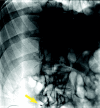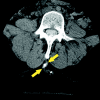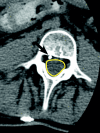Imaging evaluation of intrathecal baclofen pump-catheter systems
- PMID: 21030478
- PMCID: PMC7966068
- DOI: 10.3174/ajnr.A2211
Imaging evaluation of intrathecal baclofen pump-catheter systems
Abstract
ITB pumps are widely used in the treatment of intractable spasticity for many clinical indications, including cerebral palsy and spinal cord injury. High-dose intrathecal administration places the patient at significant risk for withdrawal in the event of device malfunction, necessitating rapid and complete evaluation of the pump-catheter system. This article reviews the approach to imaging evaluation of ITB pump-catheter systems, with specific emphasis on radiography, fluoroscopy, CT, and nuclear scintigraphy.
Figures












References
-
- Penn RD, Kroin JS. Intrathecal baclofen alleviates spinal cord spasticity. Lancet 1984;1:1078. - PubMed
-
- Dralle D, Muller H, Zierski J, et al. . Intrathecal baclofen for spasticity. Lancet 1985;2:1003 - PubMed
-
- Gilmartin R, Bruce D, Storrs BB, et al. . Intrathecal baclofen for management of spastic cerebral palsy: multicenter trial. J Child Neurol 2000;15:71–77 - PubMed
-
- Van Schaeybroeck P, Nuttin B, Lagae L, et al. . Intrathecal baclofen for intractable cerebral spasticity: a prospective placebo-controlled, double-blind study. Neurosurgery 2000;46:603–09, discussion 609–12 - PubMed
-
- Becker R, Alberti O, Bauer BL. Continuous intrathecal baclofen infusion in severe spasticity after traumatic or hypoxic brain injury. J Neurol 1997;244:160–66 - PubMed
Publication types
MeSH terms
Substances
LinkOut - more resources
Full Text Sources
Medical
